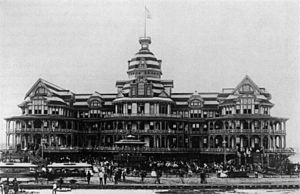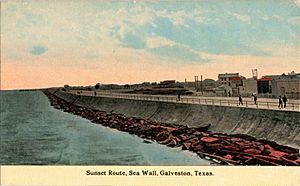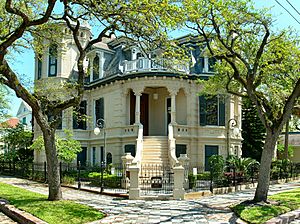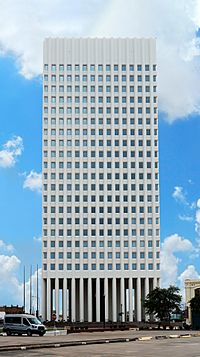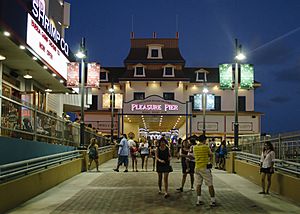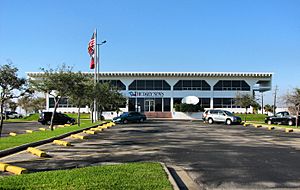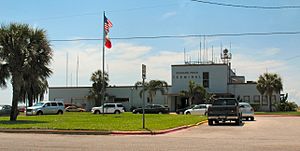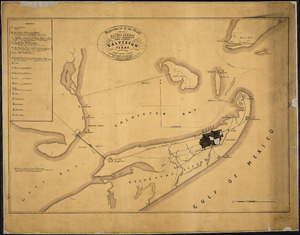Galveston, Texas facts for kids
Quick facts for kids
Galveston, Texas
|
||
|---|---|---|
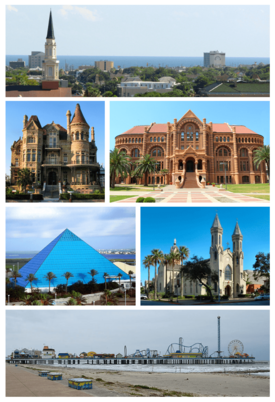
From upper left: Galveston downtown skyline, Bishop's Palace, Ashbel Smith Building, Moody Gardens Aquarium, St. Mary Cathedral Basilica and Galveston Island Historic Pleasure Pier
|
||
|
||
| Nickname(s):
"The Oleander City"
|
||
| Motto(s):
"It's Island Time"
|
||
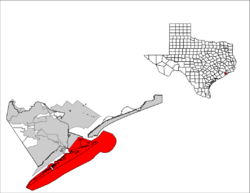
|
||
| Country | United States | |
| State | Texas | |
| County | Galveston (erected 1838) | |
| Incorporated | 1839 | |
| Named for | Bernardo de Gálvez, 1st Count of Gálvez (1746–1786) | |
| Government | ||
| • Type | Council–manager | |
| • Body | City Council | |
| Area | ||
| • City | 211.31 sq mi (547.29 km2) | |
| • Land | 41.04 sq mi (106.28 km2) | |
| • Water | 170.27 sq mi (441.00 km2) | |
| Elevation | 7 ft (2 m) | |
| Population
(2020)
|
||
| • City | 53,695 | |
| • Estimate
(2022)
|
53,089 | |
| • Rank | US: 753rd TX: 70th |
|
| • Density | 1,294/sq mi (499.5/km2) | |
| • Urban | 191,863 (US: 200th) | |
| • Urban density | 1,760.5/sq mi (679.7/km2) | |
| Demonym(s) | Galvestonian or Galvestinian | |
| Time zone | UTC–6 (Central (CST)) | |
| • Summer (DST) | UTC–5 (CDT) | |
| ZIP Codes |
77550, 77551, 77552, 77553, 77554, 77555
|
|
| Area code(s) | 409 | |
| FIPS code | 48-28068 | |
| GNIS feature ID | 1377745 | |
Galveston (/ˈɡælvɪstən/ gal-VIS-tən) is a fun resort city and port located on Galveston Island and Pelican Island in Texas. It's right off the Southeast Texas coast, on the northwestern side of the Gulf of Mexico. About 53,695 people live here, making it the second-largest city in Galveston County. It's also part of the bigger Houston–The Woodlands–Sugar Land area.
Galveston got its name from Bernardo de Gálvez, a Spanish leader from the 1700s. The first European settlements on Galveston Island were built around 1816 by a French pirate named Louis-Michel Aury. He wanted to help Mexico gain independence from Spain. The Port of Galveston was officially started in 1825 by the Mexican government.
This city was super important during the Texas Revolution in 1836. It was the main port for the new Texas Navy and even served as the temporary capital of the Republic of Texas. A very important event happened here in 1865. General Gordon Granger arrived and announced that slavery was illegal for the last enslaved people in Texas. This day, June 19, is now a national holiday called Juneteenth.
In the 1800s, Galveston became a huge trading center and one of the biggest ports in the United States. It was even Texas's largest city for a while, known as the "Queen City of the Gulf." But then, a terrible storm hit in 1900. The 1900 Galveston hurricane caused massive flooding and killed between 6,000 and 12,000 people. It's still the deadliest natural disaster in U.S. history. After the storm, the city rebuilt and became a popular tourist spot again. It was even known as the "Free State of Galveston" during the 1920s and 30s because of its lively, though sometimes illegal, entertainment scene.
Today, Galveston's economy relies a lot on tourism, health care, shipping, and money matters. The University of Texas Medical Branch is a big part of the city's economy, with many students and staff. Galveston also has six historic districts filled with beautiful 19th-century buildings. Over 60 of these buildings are listed on the National Register of Historic Places, which means they are very important to history.
Contents
Exploring Galveston's Rich History
Early Days and Growth in the 1800s
Long ago, Karankawa and Akokisa tribes lived on Galveston Island. They called it Auia. In 1528, a Spanish explorer named Álvar Núñez Cabeza de Vaca was shipwrecked nearby. He called the island "Isle of Bad Fate." Later, in 1785, another Spanish explorer, José de Evia, named it Villa Gálvez or Gálveztown after Bernardo de Gálvez.
The first permanent European homes were built around 1816 by a pirate named Louis-Michel Aury. He wanted to help Mexico fight for independence from Spain. In 1817, another famous pirate, Jean Lafitte, took over Galveston. He called it "Campeche" and made himself the leader. Lafitte stayed until 1821, when the United States Navy made him leave.
In 1825, the Mexican government officially started the Port of Galveston. In 1836, Galveston even became the temporary capital of the Republic of Texas. That same year, Michel Branamour Menard and his friends bought a large piece of land to start the modern city. As more people moved to Galveston, including many German immigrants, the city grew quickly.
Galveston had many "firsts" in Texas. It had the first post office (1836), naval base (1836), and even the first Catholic school (1847). It also got gas lights in 1856.
During the American Civil War, Confederate soldiers took over the city in 1863. Later, in 1867, Galveston faced a serious yellow fever outbreak, and 1800 people died.
After the Civil War, Galveston continued to grow. It got an opera house in 1870 and telephone lines in 1878. Many formerly enslaved people moved to Galveston, looking for new opportunities. Leaders like Norris Wright Cuney worked hard to improve education and jobs for African Americans. Galveston was a very welcoming city during this time.
By the late 1800s, Galveston had about 37,000 people. It was a major center for trade, especially cotton. The Strand area was known as the "Wall Street of the South" because of all the businesses there. The government also built defenses like Fort Crockett to protect the city.
The Great Storm of 1900 and Rebuilding
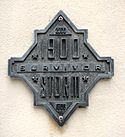
On September 8, 1900, a massive hurricane hit Galveston. It was the deadliest natural disaster in U.S. history, killing an estimated 6,000 to 8,000 people. The city was almost completely destroyed.
After the storm, people built a huge seawall, 10 miles long and 17 feet high, to protect the city from future floods. They also raised much of the city's land to a higher level. This was a huge engineering project!
Even with all the rebuilding, Galveston never became as important as it was before the storm. The new Houston Ship Channel also meant that Port of Houston became a big competitor. To help the city recover, Galveston encouraged new people to move there. Between 1907 and 1914, about 10,000 Jewish immigrants from Eastern Europe came to Galveston. Many other groups, like Greeks and Italians, also moved to the city.
In the 1920s and 1930s, Galveston became a popular tourist spot again. Companies like American National Insurance Company and Moody National Bank were started, helping the city's economy. During World War II, the airport became a U.S. Army Air Corps base. The Moody Foundation was also created to help Texans, and it has done a lot for Galveston over the years.
Modern Galveston: A New Era
After World War II, the military presence on the island decreased. Also, gambling, which had been popular, became less common as laws were enforced and Las Vegas grew. This caused tourism to slow down for a while.
But Galveston didn't give up! In 1957, the Galveston Historical Foundation started working to save old buildings. This led to the restoration of areas like the Strand Historic District. The city focused on family-friendly tourism.
Higher education also grew in the 1960s. The University of Texas Medical Branch expanded, and new schools like the Texas Maritime Academy (now Texas A&M University at Galveston) and Galveston College were created.
In 2008, Hurricane Ike hit Galveston, causing a lot of damage. But the city rebuilt again, focusing on tourism, shipping, and its universities and hospitals. New attractions like the Galveston Island Historic Pleasure Pier were added.
Galveston's Location and Special Places
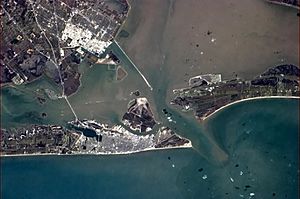
Galveston is on Galveston Island, which is a barrier island off the Texas coast. This island is mostly made of sand and can change shape due to water and weather.
The city is about 45 miles southeast of downtown Houston. The island has the Gulf of Mexico to the east and south, and Galveston Bay to the north. You can get to the island from the mainland by crossing the Interstate 45 causeway.
Galveston's harbor is connected to the Gulf by a deep channel. The city covers about 211 square miles, but most of that is water (about 170 square miles). The island itself is about 50 miles southeast of Houston.
The western part of Galveston is called the "West End." Many people there use golf carts to get around! In 2011, a study suggested that the West End is eroding quickly and that building there should be limited.
{{wide image|Galveston East End Panoramic.jpg|880px|A wide view of Galveston looking southeast toward the Gulf of Mexico. Downtown Galveston and the Strand Historic District are on the right.]]
Exploring Historic Districts
Galveston is famous for its six historic districts. These areas have over 60 buildings that are important for their architecture and history. The Silk Stocking National Historic District has many homes built from the Civil War to World War II. The East End Historic District has 463 historic buildings.
The Strand National Historic Landmark District is a special area with many Victorian era buildings. These buildings are now home to restaurants, antique shops, museums, and art galleries. It's a major tourist spot and the center for fun events like the yearly Mardi Gras festival and Dickens on the Strand, a Victorian-themed Christmas festival.
Galveston's Weather
| Weather chart for Galveston | |||||||||||||||||||||||||||||||||||||||||||||||
|---|---|---|---|---|---|---|---|---|---|---|---|---|---|---|---|---|---|---|---|---|---|---|---|---|---|---|---|---|---|---|---|---|---|---|---|---|---|---|---|---|---|---|---|---|---|---|---|
| J | F | M | A | M | J | J | A | S | O | N | D | ||||||||||||||||||||||||||||||||||||
|
4.1
62
50
|
3.6
64
52
|
3.8
70
58
|
3.6
75
65
|
3.7
81
72
|
5
87
78
|
5.5
89
80
|
6.2
89
80
|
8.8
87
76
|
5.5
80
68
|
4.6
71
59
|
4.5
64
52
|
||||||||||||||||||||||||||||||||||||
| temperatures in °F precipitation totals in inches source: National Weather Service Forecast Office Houston/Galveston, Texas: Galveston Climate Data |
|||||||||||||||||||||||||||||||||||||||||||||||
|
Metric conversion
|
|||||||||||||||||||||||||||||||||||||||||||||||
Galveston has a humid subtropical climate. This means it has hot, humid summers and mild winters. Summer temperatures often go above 90°F (32°C), and the humidity makes it feel even hotter. Winters are usually mild, with temperatures above 60°F (15°C). Snow is very rare here.
Hurricanes are a threat during the summer and fall. Galveston Island and the Bolivar Peninsula are most at risk from these storms.
| Climate data for Galveston, Texas (Scholes Int'l), 1981−2010 normals, extremes 1871−present | |||||||||||||
|---|---|---|---|---|---|---|---|---|---|---|---|---|---|
| Month | Jan | Feb | Mar | Apr | May | Jun | Jul | Aug | Sep | Oct | Nov | Dec | Year |
| Record high °F (°C) | 78 (26) |
83 (28) |
87 (31) |
95 (35) |
94 (34) |
100 (38) |
101 (38) |
100 (38) |
104 (40) |
94 (34) |
85 (29) |
80 (27) |
104 (40) |
| Mean daily maximum °F (°C) | 61.8 (16.6) |
64.3 (17.9) |
70.2 (21.2) |
75.9 (24.4) |
83.0 (28.3) |
88.2 (31.2) |
89.6 (32.0) |
90.3 (32.4) |
87.4 (30.8) |
80.6 (27.0) |
71.6 (22.0) |
63.9 (17.7) |
77.2 (25.1) |
| Mean daily minimum °F (°C) | 48.6 (9.2) |
50.9 (10.5) |
56.6 (13.7) |
64.4 (18.0) |
72.3 (22.4) |
77.5 (25.3) |
79.4 (26.3) |
79.7 (26.5) |
75.9 (24.4) |
68.1 (20.1) |
58.6 (14.8) |
50.7 (10.4) |
65.2 (18.4) |
| Record low °F (°C) | 11 (−12) |
8 (−13) |
26 (−3) |
38 (3) |
50 (10) |
57 (14) |
66 (19) |
67 (19) |
52 (11) |
39 (4) |
26 (−3) |
14 (−10) |
8 (−13) |
| Average rainfall inches (mm) | 4.20 (107) |
2.57 (65) |
3.16 (80) |
3.05 (77) |
4.32 (110) |
5.69 (145) |
3.80 (97) |
4.39 (112) |
6.03 (153) |
5.52 (140) |
4.51 (115) |
3.52 (89) |
50.76 (1,290) |
| Mean monthly sunshine hours | 145.0 | 163.4 | 209.0 | 225.5 | 265.7 | 298.5 | 309.0 | 280.4 | 237.9 | 237.2 | 176.9 | 150.5 | 2,699 |
| Percent possible sunshine | 44 | 52 | 56 | 58 | 63 | 71 | 72 | 69 | 64 | 67 | 55 | 47 | 61 |
| Source 1: NOAA (sun 1961–1990) | |||||||||||||
| Source 2: The Weather Channel The Washington Post (June record high) | |||||||||||||
| Climate data for Galveston, Texas (COOP station), 1981−2010 normals | |||||||||||||
|---|---|---|---|---|---|---|---|---|---|---|---|---|---|
| Month | Jan | Feb | Mar | Apr | May | Jun | Jul | Aug | Sep | Oct | Nov | Dec | Year |
| Record high °F (°C) | 83 (28) |
83 (28) |
86 (30) |
92 (33) |
94 (34) |
99 (37) |
101 (38) |
103 (39) |
100 (38) |
94 (34) |
88 (31) |
84 (29) |
103 (39) |
| Mean daily maximum °F (°C) | 61.0 (16.1) |
63.1 (17.3) |
68.6 (20.3) |
74.7 (23.7) |
81.7 (27.6) |
87.1 (30.6) |
89.2 (31.8) |
89.8 (32.1) |
86.5 (30.3) |
79.7 (26.5) |
71.3 (21.8) |
64.1 (17.8) |
76.4 (24.7) |
| Mean daily minimum °F (°C) | 45.1 (7.3) |
47.3 (8.5) |
54.1 (12.3) |
62.0 (16.7) |
70.6 (21.4) |
76.1 (24.5) |
77.9 (25.5) |
77.8 (25.4) |
73.3 (22.9) |
66.1 (18.9) |
56.5 (13.6) |
47.3 (8.5) |
62.8 (17.1) |
| Record low °F (°C) | 11 (−12) |
8 (−13) |
26 (−3) |
37 (3) |
52 (11) |
57 (14) |
67 (19) |
51 (11) |
52 (11) |
39 (4) |
29 (−2) |
14 (−10) |
8 (−13) |
| Average rainfall inches (mm) | 3.69 (94) |
2.99 (76) |
2.85 (72) |
2.19 (56) |
3.01 (76) |
4.83 (123) |
3.85 (98) |
3.35 (85) |
5.36 (136) |
4.15 (105) |
3.42 (87) |
3.36 (85) |
43.05 (1,093) |
| Average rainy days (≥ 0.01 in) | 9.8 | 8.5 | 6.9 | 5.0 | 6.1 | 7.7 | 7.7 | 6.9 | 8.0 | 7.1 | 8.2 | 8.2 | 90.1 |
| Source: NOAA | |||||||||||||
People and Population
| Historical population | |||
|---|---|---|---|
| Census | Pop. | %± | |
| 1850 | 4,177 | — | |
| 1860 | 7,307 | 74.9% | |
| 1870 | 13,818 | 89.1% | |
| 1880 | 22,248 | 61.0% | |
| 1890 | 29,084 | 30.7% | |
| 1900 | 37,789 | 29.9% | |
| 1910 | 36,981 | −2.1% | |
| 1920 | 44,255 | 19.7% | |
| 1930 | 52,938 | 19.6% | |
| 1940 | 60,862 | 15.0% | |
| 1950 | 66,568 | 9.4% | |
| 1960 | 67,175 | 0.9% | |
| 1970 | 61,809 | −8.0% | |
| 1980 | 61,902 | 0.2% | |
| 1990 | 59,070 | −4.6% | |
| 2000 | 57,247 | −3.1% | |
| 2010 | 47,743 | −16.6% | |
| 2020 | 53,695 | 12.5% | |
| 2022 (est.) | 53,089 | 11.2% | |
| U.S. Decennial Census 2020 Census |
|||
In 2020, Galveston had 53,695 people living there. The city is home to many different groups of people. About 47% of the population is White, and about 16% is Black or African American. Around 29% of the people are of Hispanic or Latino background.
In 2010, there were 47,743 people in Galveston. The average age was 36 years old. About 23% of the population was under 13 years old.
Galveston's Economy and Fun Activities
The Busy Port of Galveston
The Port of Galveston, also known as Galveston Wharves, started as a trading post way back in 1825. Today, it's a huge port with over 850 acres of facilities. It handles all kinds of cargo, like containers, dry goods, and even refrigerated items.
The port is also a popular place for cruise ships. Many big cruise lines, like Carnival Cruise Lines, Royal Caribbean International, and Disney Cruise Line, have ships that sail from Galveston to the Caribbean and the Bahamas. Galveston is the top cruise port on the Gulf Coast and ranks fourth in the United States!
Key Businesses in Galveston
American National Insurance Company, one of the biggest life insurance companies in the U.S., is based in Galveston. They operate in all 50 states. Moody National Bank, also headquartered in downtown Galveston, is one of the largest privately owned banks in Texas.
Tourism: Fun for Everyone!

Galveston has always been a popular place for visitors. In the late 1800s, it was called the "Playground of the South." Today, it's still a top tourist spot, bringing in millions of visitors and a lot of money to the local economy.
There are many places to stay, from historic hotels like the Hotel Galvez to cozy bed and breakfast inns. Fun attractions include the Galveston Island Historic Pleasure Pier, the Galveston Schlitterbahn waterpark, and Moody Gardens with its amazing pyramids. You can also visit the Ocean Star Offshore Drilling Rig & Museum, the Lone Star Flight Museum, and the Galveston Railroad Museum. The Strand area is great for shopping, dining, and exploring historic buildings.
Galveston is also home to several historic ships. You can visit the tall ship Elissa at the Texas Seaport Museum. There are also two Navy ships, the USS Cavalla and USS Stewart, at Seawolf Park.
Arts and Culture in Galveston
Galveston Arts Center
The Galveston Arts Center (GAC) is a non-profit organization that shows modern art, often by Texas artists. They also have educational programs. GAC organizes the Galveston ArtWalk, where you can explore art around the city. Entry to the museum is free!
The GAC is in a historic building that was damaged by Hurricane Ike in 2008. But after a lot of fundraising, it was beautifully restored and reopened in 2015.
Galveston ArtWalk
ArtWalk happens about every six weeks on Saturday evenings. The Galveston Arts Center provides a map of all the places showing art, like galleries and artist studios. You can also find art in coffee shops and outdoors at the Art Market. Musicians often perform during ArtWalk too.
Music and Performing Arts
Galveston has a lively music and arts scene.
- Galveston Symphony Orchestra: This orchestra was formed in 1979 and includes both amateur and professional musicians.
- Galveston Ballet: This is a pre-professional ballet company that performs classical ballets and other dance shows at the Grand 1894 Opera House.
Art Spaces and Sculptures
- Galveston Artist Residency: This program gives studio and living space to three artists each year. They work on their art and show it in the GAR Gallery.
- The National Hotel Artist Lofts: These lofts provide affordable living and working spaces for artists in a historic building. The building also has a bar and gallery called the Proletariat Gallery & Public House, which hosts art shows and live music.
Galveston also has many interesting statues and sculptures, including:
- 1900 Storm Memorial
- Texas Heroes Monument
- Pink Dolphin Monument
Education in Galveston
Colleges and Universities
Galveston is home to important colleges and universities:
- University of Texas Medical Branch (UTMB): Started in 1891, UTMB is a large campus with over 70 buildings and more than 2,500 students. It has schools for medicine, nursing, and other health professions. It also has hospitals and research facilities. UTMB is a major healthcare provider in the region.
- Galveston College: This is a junior college that opened in 1967.
- Texas A&M University at Galveston: This is a branch campus of Texas A&M University that focuses on ocean-related studies.
Schools for Younger Students
The Galveston Independent School District serves the city. It has six elementary schools, two middle schools, and one high school, Ball High School. There's also a special magnet middle school, Austin Middle School.
Galveston also has several charter schools, like Ambassadors Preparatory Academy and Odyssey Academy. There are also private schools, including Catholic schools like Holy Family Catholic School and O'Connell College Preparatory School. Other private schools include Satori Elementary School and Trinity Episcopal School.
Media and News
The Daily News is Galveston's main newspaper. It started in 1842 and is the oldest continuously printed newspaper in Texas. It's the official newspaper for the city.
City Services and Transportation
Healthcare Services
Galveston has some of the biggest teaching hospitals in Texas at the University of Texas Medical Branch. After Hurricane Ike, the hospital was damaged, but it has been rebuilt and expanded. It now has around 600 beds and a Level I Trauma Center for serious injuries.
The city is also home to the Shriners Burns Hospital at Galveston. This hospital provides special care for children with severe burns.
Public Safety and Libraries
The Galveston Fire Department has six fire stations to protect the city. The Galveston Police Department has over 170 officers.
The Rosenberg Library serves the city. It's the oldest public library in Texas, founded in 1871. It's also the main library for Galveston County.
Getting Around Galveston
By Sea
Galveston is a top cruise port. You can also see historic ships like the Elissa and the USS Cavalla at the Texas Seaport Museum and Seawolf Park.
By Air
Scholes International Airport at Galveston is Galveston's airport. It's mainly used for private planes and flights for offshore energy companies. For bigger flights, people use William P. Hobby Airport or George Bush Intercontinental Airport in Houston.
By Train
The Galveston Railroad moves cargo to and from the Port of Galveston. It connects with major railway companies. Galveston used to have passenger train service, but now you can take an Amtrak bus to connect to trains in Houston.
By Road
Galveston's streets are laid out in a grid pattern. The main highway is Interstate 45, which connects Galveston to the mainland and Houston. Farm to Market Road 3005 (also called Seawall Boulevard) connects Galveston to Brazoria County. Texas State Highway 87 (Broadway Street) connects the island to the Bolivar Peninsula by ferry.
 I-45
I-45 SH 87
SH 87 FM 3005
FM 3005
Public Transportation
Island Transit runs the city's public transportation, including the Galveston Island Trolley. You can also find intercity bus services to Galveston.
Famous People from Galveston
Many important people have called Galveston home:
- Jean Lafitte: A famous pirate and hero from the War of 1812.
- Richard Bache, Jr.: Grandson of Benjamin Franklin, who helped write the Texas Constitution.
- Norris Wright Cuney: An important civil rights leader who worked to improve opportunities for African Americans.
- King Vidor: A Hollywood director who made his first film about the 1900 hurricane.
- Jack Johnson: Nicknamed the "Galveston Giant," he was the first black world heavyweight boxing champion.
- William L. Moody Jr.: A businessman who started the American National Insurance Company and the Moody Foundation.
- Barry White: A Grammy-winning singer-songwriter.
- George P. Mitchell: A pioneer in hydraulic fracturing technology.
- Anita Martini: A groundbreaking female sports journalist.
- Tilman J. Fertitta: A successful businessman who owns many restaurants and entertainment venues.
- Kay Bailey Hutchison: The first female U.S. Senator from Texas.
- Matt Carpenter: A professional baseball player for the St. Louis Cardinals.
- Mike Evans: A wide receiver for the Tampa Bay Buccaneers.
- Tina Knowles: A fashion designer and mother of Beyoncé and Solange Knowles.
- Esther Phillips: A Grammy-winning R&B and Jazz legend.
Sister Cities
Galveston has special connections with other cities around the world:
 Macharaviaya, Spain
Macharaviaya, Spain Niigata, Japan
Niigata, Japan Stavanger, Norway
Stavanger, Norway Veracruz, Mexico
Veracruz, Mexico
See also
 In Spanish: Galveston para niños
In Spanish: Galveston para niños





